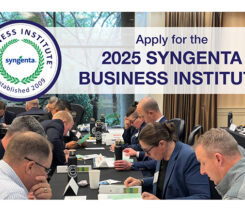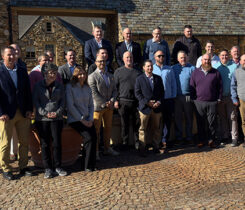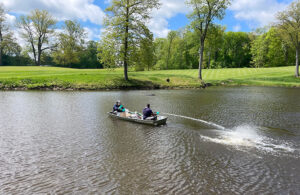Big on Bio
Bionutritional products have made a believer out of Roch Gaussoin, who previously preferred them about as much as the general public liked the taste of New Coke when it was rolled out in 1985 to replace the company’s original cola.
Gaussoin, Ph.D., a professor of agronomy and horticulture at the University of Nebraska-Lincoln, said he once dismissed bionutritional products — the name given to the range of living organisms such as microbes, bacteria, mycorrhizae, seaplant extracts and hormones — as “snake oil” and “bugs in a jug.” But after further review, literally, Gaussoin said golf course superintendents would be making a big mistake if they rejected the products as junk science.
Gaussoin spoke at an event, “Bionutrition: From Bugs in Jugs to Mainstream Fertility,” held by LebanonTurf in September at the Otesaga Resort in Cooperstown, N.Y. LebanonTurf, which acquired the bionutritional product companies Emerald Isle Solutions in 2008 and the Roots brand from Novozymes in 2009, has diversified its product offering of turfgrass fertilizers, which also includes traditional N-P-K products, to better serve its customers’ needs. The event also featured speakers Robert Ames, Ph.D., a senior staff scientist for Advanced Microbial Solutions; Mike Amaranthus, Ph.D., an adjunct associate professor at Oregon State University and president of Mycorrhizal Applications Inc.; and Robin Ross, market development scientist in the plant science division for Acadian Seaplants Limited. All spoke on the benefits that bionutritional products add to turfgrass maintenance programs when used in conjunction with conventional fertilizers.
 Bernie Banas says the lake behind him, Otsego Lake, was the reason he introduced bionutritional products to his maintenance program. |
Gaussoin said he was skeptical of bionutritional products until he began testing some of the products — and then his eyes were opened to their benefits. His tests revealed that using bionutritional products could provide superintendents the opportunity to reduce fertilizer application rates by up to 30 percent over granular or dry fertilizers with no change in performance. Gaussoin also said bionutritional products help improve soil structure and plant root health.
Gaussoin’s research also revealed bionutritional products play a major role in unlocking labile nutrients that are locked in the soil as a result of organic matter deposition.
“The only way those nutrients will be released is by some sort of biological activity,” Gaussoin said. “That nitrogen is waiting to be released. We just need some biological condition, primarily microbial-based, to release it to the plant.”
Next to water, bionutrients are the most important attribute for plant health, Gaussoin added
“That’s how important they are, but we pigeonhole them in a black box because we’re not sure how they work,” he said.
Gaussoin and the other speakers admitted they’re not entirely sure how bionutritional products function.
“We thought it was simply adding an organism,” Gaussoin said. “But it may not be the organism; it may be what the organism produces when it dies.”
Gaussoin said he doesn’t think superintendents care how bionutritional products function. If the products are backed by solid research and positive peer review, superintendents will consider using the products.
In her presentation, Ross noted that bionutritional products, such as those containing seaweed extract, enable turfgrass to elicit its natural defenses to stress.
“The products help plants tolerate drought stress, salinity stress and temperature extremes,” she said. “A typical fertility product doesn’t do anything when you’re trying to grow bentgrass in hot conditions, and the turf’s roots are getting shorter and shorter. But bionutritional products can help with that.”
 Mike Amaranthus, Ph.D., says there are many environmental benefits from using bionutritional products. |
Ames touted the economic benefits of bionutritional products, which cost more than conventional fertilizers on a per-unit nitrogen basis, including reduced irrigation, a reduction in nutrient loss and overall reduction of maintenance costs associated with reduced pesticide control because of healthier turf.
“[Using] bionutritional products is equivalent to having insurance,” Ames said. “They provide long-term assurance for a low cost.”
Amaranthus said superintendents need to be smart about what they look for in biological products because there are some lousy products on the market.
“Just like any industry, you have a whole range of quality and a whole range of active ingredient that’s given you the response,” he said. “And you really want to look for the form of the product that best suites your needs.”
Amaranthus also noted the environmental benefits of bionutritional products, such as improving runoff water quality, reducing groundwater pollution, creating carbon sequestration in soil and offsetting greenhouse gases.
To find a golf course superintendent who has incorporated bionutritional products in his golf course maintenance program, one had to look no further than Otesaga Resort’s Leatherstocking Golf Course, where Bernie Banas is superintendent.
When Banas began at Leatherstocking in 1994, his aim was to upgrade the course’s maintenance program environmentally to protect the pristine and picturesque Otsego Lake, the 10-mile long waterway that borders the resort and is Cooperstown’s drinking water supply.
“That’s when I started looking at organic products, Banas said. “But they were fairly new then, and nobody knew much about them.”
Banas started using the products on the course’s fairways. He first tried a poultry-based product, using it by itself and as with a synthetic fertilizer.
“I saw tremendous results after a few years,” Banas said. “I was able to reduce the severe thatch in the fairways.”
Banas then began using bionutritional products on his course’s greens and liked the results just as much.
Banas uses several nutritional products — organic and synthetic — in his turf maintenance program.
“I don’t think there’s one organic or synthetic product that will do the job on its own,” he said. “It’s a combination of them.”
 Superintendent Bernie Banas says his use of bionutritional products have helped the turfgrass stay healthy at Leatherstocking Golf Course. |
But Banas said bionutritional products alone have helped improve plant health to offset turf disease. When he came to Leatherstocking, Banas said he tried everything under the sun to withstand anthracnose, but couldn’t find anything that worked — until he began making monthly applications of bionutritional products with sea plant extract.
“I haven’t seen any anthracnose in 12 years,” he said. “The root system is 10 times stronger than the root system we had before. It all relates to plant health. The stronger the plant, the more it will be able to take.”
It was a difficult summer for superintendents with record heat and humidity, and many superintendents lost turf. But Banas said his course’s turf thrived, which he attributes to his use of bionutritional products.
“This was the hottest and driest summer I’ve ever encountered,” he said. “The turf made it through because of those products.”
Because the turfgrass is healthier, Banus said he has less problems with weeds and insects. The healthy turf crowds out weeds. And the healthy turf has led to few grubs that don’t cause much damage, if any.
“We do very little weed control,” Banas said. “We spot spray where we need to. Occasionally, we have to go out and knock down grub populations. But we scout for them. There are few times when we’ve had to make blanket applications.”
Banas said cost was a concern when he began using bionutritional products, but he has saved money in other areas since incorporating them into his maintenance program. Mainly, he has saved money by reducing other inputs. He has also benefited from the recent drop in fungicide prices.
“I can honestly say that I’m spending less money than I was 12 years ago,” he said of his maintenance budget.
Superintendents need to be patient with bionutritional products if they decide to use them, Banas said.
“It might take awhile for them to see the full benefits,” he added, noting they will see a lesser but positive impact early when using them.
Gaussoin, who’s glad he decided to look into bionutritional products with an open mind, said he hopes others do the same.
“Biological products aren’t widely accepted by the academic community,” Gaussoin said. “But I think we’re coming around like some superintendents.”
In 10 years, Gaussoin expects superintendents to be using bionutritional products they say they can’t live without.
“I think that’s where we’re heading,” he added. “We’re learning a lot more about them.”












